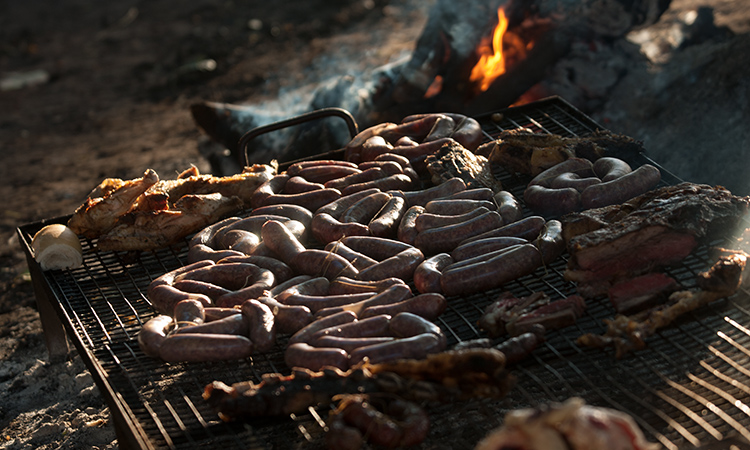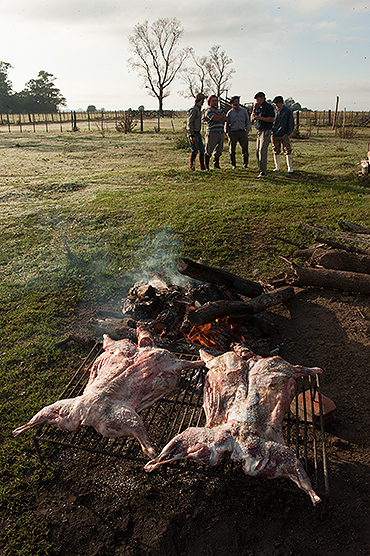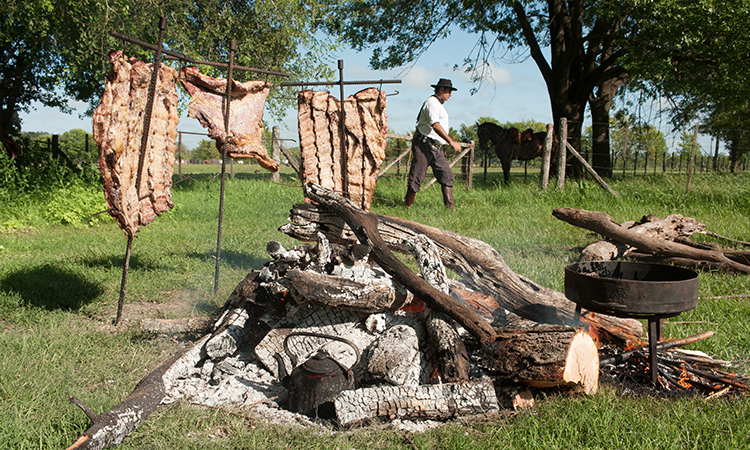The asado, the star of Argentinian gastronomy
The football, the tango, the dulce de leche, what’s more famous in Argentina than these clichés? In fact, there is one phenomenon the Argentinian people is very proud of: the asado. This country’s national dish is a classic of the local gastronomy.
Argentina is one of the biggest meat consumers, with an average of 56 kg of beef per year and per capita! Made of grilled meat, its preparation is an absolute art. It also leads to social links, as each occasion is a good excuse to organise an asado amongst friends, with the family, or even with colleagues. Moreover, tourists from many horizons try their hand at this food, very different from European or North American barbecues.
What is the asado?

The asado takes its origin from the Spanish word asar, meaning to grill. In other words, the asado is a barbecue, in the manner of Argentina. This term is used to refer to the dish itself, but also to allude to its preparation technique.
Most of the time, the asado is made from vacuno (beef). It is the most consumed meat in South America. The cordero (lamb), the cerdo (pork), or the oveja (mutton) are also alternatives, rarer, but still appreciated.
The asado has several features which differ from the barbecues Europeans are used to. If you are in the habit of eating like a horse, then the asado is your ideal dish. The portions, very copious, are usually 800g per man and 600g per woman. There is no doubt you will be full for the next three days at least. The cooking time is also surprising. In Argentina, custom doesn’t involve cooking two or three sausages here and there, but rather some kilos of meat. Whether the piece is whole or not, you’ll have to wait a few hours before you delight your most sophisticated taste buds.
Where does the asado come from?
The asado originates from Argentina’s colonisation in the XVIth century. The conquistadors brought with them bullocks and cows from Northern South America, which, abandoned in the middle of thousands of hectares, proliferated and became the primary source of food. It is said that each inhabitant was allowed to own a maximum of 12.000 heads. The gauchos used to travel over long distances, bullocks were thus the easiest way to eat.
How is the asado cooked?
In the kingdom of red meat, an asado is cooked according to different ways, depending on the asador’s methods (the asado’s boss). Preparing the meat on the parilla (shelf), maintaining the fire, managing the perfect cooking are all duties a competent asador must be good at. Horizontal cooking for the smallest pieces, whereas the whole pieces are cooked vertically.
Argentinians like to eat their meat very well cooked. A long cooking time is to be expected, but the famous mate and the unmissable empanadas (other classics in the Argentinian gastronomy) are nice ways to pass the time.

In Argentina, when an asado is being prepared, the tradition consists in eating “the whole animal”. When dishing up, it is essential to respect an order, which starts with the less noble parts of the animal (tripe…) and ends with the best pieces of meat (rib steak…).
To go with meat, the Chimichurri, made from chilis, is the most common sauce, although some will prefer the less traditional sauces such as mustard, ketchup… Side dishes are more classic. Potatoes, salad, vegetables can be served with the meat.
True star in this area, Argentina appeared in the 2011 Guinness Book of World Records thanks to the biggest asado ever: 13 tons of beef meat grilled for 30.000 guests, a record! Whether you are passing through Argentina for tourism, business or out of curiosity, the asado is unmissable. You will be immersed into a world of exotic savours while sharing the secrets of Argentina’s gauchos.
Get the meat
Common choices are:
- Chorizo: small pork sausage
- Morcilla: blood sausage
- Tira de asado: the perennial favorite, short ribs
- Vacío: flank steak
- Bife ancho: rib-eye steak
- Lomo: tenderloin
- Mollejas: sweetbreads, delicious when cooked until crispy on a hot fire with plenty of lemon
Gather materials
You’ll also need:
Wood or charcoal. If you have to use charcoal, remember the golden rule: only use the coals once they are burned through and red hot to avoid any noxious flavors.
– The bread: mini-baguettes that are perfectly cut chorizo-sized.
– Cheese and salamis: the picada or starter.
– The wine: arm yourself with a couple of good Malbecs.
– Fernet and coke: ditto.
– Provoleta: rounds of provolone cheese with herbs and pepper served in tin foil plates ready for tossing onto grill.
– Sal gruesa: course barbecue salt, to be applied very liberally to the meat.
– Salad: usually limited to a very basic green salad.
Designate a leader
Now you’re all set and the asador will be nominated. Once designated, for better or worse, he or she is in charge of the process from the start to the end – and no interference is tolerated. A real asador will have a razor sharp, thick bladed gaucho knife that slips into the belt.
Get the coals ready
Spread the coals out under the grill in a rectangular shape (nothing in the middle), creating a gentle, even heat from all sides. Always be sure to keep a fire going on the side to ensure that you have enough coals for at least an hour. Slow cooking is key; the temperature is right when you hear a gentle but constant sizzling.
Time to cook
Add the beef, chorizos, morcilla, and cheese to the grill at the same time to break the asado up into various courses.
First off, the grill will be the provoleta, cut into delicious molten squares to be passed. Next up, the morcilla, as it only needs to be warmed through before serving. Then the chorizos, served with mini-baguettes and a good chimichurri to make the classic choripan. (of course, the chef remembered to toast the bread lightly on the grill for a minute before serving the sausages.)
Finally, the meat, the climax of the event.
Cook like an expert
Remember, bone-side down, fat up, for most of the time, which can be around 45 minutes in total. Never cut into it, turn it only once, and when ready, remove from the grill, slice it up into portions, and dole it out to the waiting hordes.
Once the meat is served and everybody has tucked away to chat with their asado partner, someone calls out for a round of applause for the asador and everyone pauses, raises their greasy faces and sated eyes to the hero of the day and claps, at length and with a gusto. It means the same thing in every language: job well done.







